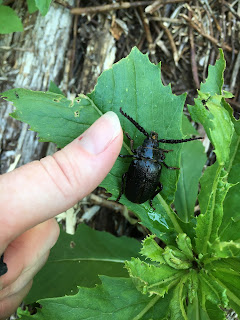Often I find bugs that I am amazed I was able to see, because they are small, or blend in so well, or are hiding somewhere, but it was really hard to miss today's Backyard Bug of the Day:
This enormous beetle was right in the middle of the path when we went on our woods walk today. I was unable to find it in my bug books, but it might be a roughnecked beetle.
Thumb for scale.
Other Bugs:
Fish fly. The first time I ever saw one of these was back before I got interested in bugs, and I thought it was a dragonfly. Years later I found out what it really was, and felt silly about my mistake because it really is nothing like a dragonfly. But it's like scientists saying that people used to not be able to see the color blue (that doesn't make sense to me, but I have read it in several places). The first time I heard about that, the thing I read was confusing, and said that people could not see blue because they didn't have a word for it. In reality I think, from other things I have read, that it's more that people didn't have a word for it because they didn't see it. It still makes no sense to me, and this is turning out to be a terrible analogy, but the first time I saw a fish fly I thought it was a dragonfly because I knew what dragonflies were, and had no idea that fish flies existed. So even though they aren't really much alike, they are enough alike that I couldn't see the differences because I didn't know that there was a difference. All right, just ignore all of that nonsense, and admire this elegant insect, which really has very little in common with a dragonfly.
Still only two stinkbug eggs have hatched, and those two nymphs are still hanging around.
Still lots of bees on the milkweed:
Not just bumblebees, can you see the small bee?
It's a little easier to see here.
Last week (I think; time has no meaning anymore) I found a lot of lace bug nymphs on the leaves of a tree. Today I noticed that there were only a few nymphs, and quite a few adult lace bugs:
Obviously, some of the nymphs are now adults, and the ones that are still nymphs were earlier instars last week.
I think what we have here is two lace bugs that have recently molted, one of them into an adult, and another into a new instar as a nymph. I think that because of their pale colors, and because you can see on the ridge of the leaf that there is an exuvia, an empty, discarded exoskeleton that the new adult probably very recently came out of.
I think this is a green lacewing larva:
It was crawling all over the flowers of a daisy fleabane plant.
On that same plant were some camouflaged looper caterpillars:
They stick bits of plant debris all over themselves so that instead of looking like caterpillars, they look like bits of plant debris.
It obviously works pretty well; the lacewing larva walked right over this one. Interestingly, green lacewing larvae will sometimes do the same thing, covering themselves with the carcasses of the aphids they have eaten, along with other bits of debris, so when you see them they look like ambulatory balls of trash. But this one has not done that.
Firefly:
You can just see the light area of its body.
Dragonfly
Robber fly
A very uncooperative monarch butterfly visited the milkweed patch, coming and going and being very unwilling to pose for nice pictures. It was a male, so it was only there to feed, not lay eggs. Speaking of which, the monarch egg I found last week is gone. I haven't been able to find it the last few days, and based on timing I don't think it hatched, which means something ate it.
Katydid nymph
Two beetles on milkweed, and on the leaf to the left...
... an assassin bug.
Assassin bug nymph

























No comments:
Post a Comment